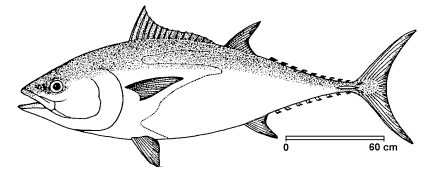
Thunnus thynnus Linnaeus, 1758

Synonyms: Scomber thynnus Linnaeus, 1758; Scomber thynnus Risso, 1810; Thynnus vulgaris Cuvier, 1832; Thynnus brachypterus Moreau, 1881; Thynnus thynnus Frade, 1931; (Thynnus) thynnus Fraser-Bruner, 1935
Common names: Engl: Bluefin tuna; Bulg: Tunets; Georg: Chveulebrivi tinusi, Cisperi tinusi; Rom: Ton, ton rosu; Russ: Tunets; Turk: Orkinos; Ukr: Tunets
Order: PERCIFORMES
Family: SCOMBRIDAE
Taxonomic descriptions: Large fish of fusiform and rounded body (nearly circular in cross-section), very robust in front; immature specimens are more slender; relatively large head with small eyes; a raw of small, conic and pointed teeth on both jaws; teeth on vomer and palatins; 9 to 10 dorsal and 8 to 9 anal finlets; two dorsal fins separated only by a narrow interspace, the second higher than the first; pectoral fins very short, never reaching the interspace between the dorsal fins; 2 separate flaps (interpelvic process) between the pelvic fins; a well developed, although not particularly conspicuous corselet (area behind the head and around the pectoral fins covered with larger and thicker scales); very small scales on the rest of the body; on each side of the caudal peduncle, a strong lateral keel between two small keels located at the bases of the caudal fin lobes; back dark-blue or back, lower sides and belly silvery-white with colourless transverse lines alternated with rows of colourless dots (the latter dominate in older fish), visible only in fresh specimens; first dorsal fin yellow or bluish, the second reddish-brown; anal fin and finlets dusky yellow edged with black; lateral keel black in adults.
 IUCN
Status:
IUCN
Status:
World level:
Black Sea Regional level: EN
Subregion level: EN
Distribution:
Habitats type, Critical habitats, Limiting factors: A pelagic species; immature species are found in warm waters only, while adults also enter cold waters in search of food. Present throughout the Mediterranean and Black Sea; common mainly along the North African coasts, from Gibraltar to Libya, off the coasts of Spain and France, around Sicily and Sardinia, in the Bosphorus and the Black Sea; also widely distributed in the Atlantic Ocean, extending as far north as Newfoundland, northern coasts of Norway, Lofoten Islands and Iceland. The pollution of Marmara and the lack of food.
Biology: Very fast swimming species known to effect transoceanic migrations; generally, the young form schools, sometimes together with other scombroids of similar size; in the Black Sea it enters each spring, staying here till October-November; in the end of summer it spawns; pelagic eggs; before the reproducing season it is a voracious predator, eating all sorts of fish, crustaceans and cephalopods.
Population trends: Large reduction in stocks, up to disappearance. On the Romanian littoral, species has not been found in the catches for the last three decades. No catch in the Turkish coasts for at least the last five years.
Threats: Pollution.
Conservation measures taken: None.
Conservation measures proposed: Mitigative measures to reduce the anthorpogenic pollution.
References:
Compiled by: G.Radu, F.Verioti, B.Öztürk